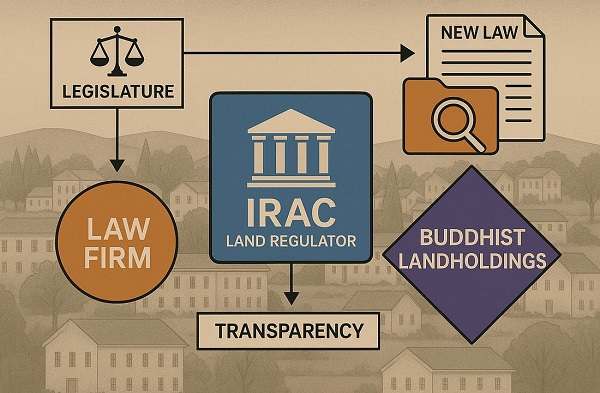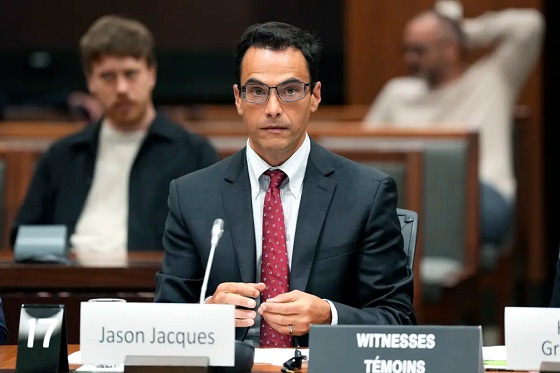Business
28 energy leaders call for eliminating ALL energy subsidies—even ones they benefit from

Energy Talking Points by Alex Epstein
 Alex Epstein
Alex Epstein
This is the kind of integrity we need from industry—and from Congress.
Dear Chairman Smith and Chairman Crapo:
We, the undersigned American energy producers and investors, write to voice our principled support for full repeal of the Inflation Reduction Act’s (IRA) energy subsidies, including subsidies that would appear to be to our firms’ and industry’s benefit. This is the only moral and practical path forward if we are to truly unleash American energy.
In recent weeks, Congress has been embroiled in battles over which, if any, of the IRA energy subsidies to cut. Lobbyists representing every corner of the energy landscape, including trade groups that many of us are part of, are jockeying to preserve their own piece of the pie, claiming that it is uniquely valuable.
We have oil lobbyists fighting to keep carbon capture and hydrogen subsidies, solar and wind lobbyists fighting to keep solar and wind subsidies, biofuel lobbyists fighting to keep biofuel subsidies, and EV lobbyists fighting to keep EV subsidies.
If this continues, we will likely preserve most if not all of the subsidies, which, deep down, everyone knows are not good for America.
The fundamental truth about subsidies is very simple. For any product, including energy, a subsidy is just a way of taking money from more efficient producers—and from taxpayers—and giving it to less efficient producers. The result is always less efficient production and therefore higher costs or lower quality for Americans.
The most egregious example of subsidies’ destructiveness is the IRA’s solar and wind subsidies, which pay electric utilities to invest much more money in solar and wind than they otherwise would, and thus much less in coal and gas than they otherwise would. Ultimately this means higher electricity prices and certainly less electricity reliability for Americans.
The IRA subsidies’ devastating harm to American energy is more than enough to compel us, as energy producers, to oppose them.
But their harm goes far beyond energy, as they will dramatically increase our debt and ultimately undermine every aspect of our economy.
A central Congressional priority is to curb the national debt during the upcoming budget reconciliation exercise. But according to credible estimates, the IRA will cost over $1 trillion over the next decade and trillions more after that. Worse, the IRA subsidies are expected to misallocate, into uncompetitive business and jobs, $3 trillion of investment by 2032 and $11 trillion by 2050. That’s a disaster for our economy, and for real job opportunities.
Clearly, the right thing to do is to eliminate all these subsidies. When lobbyists say that these subsidies are essential for America, what they’re really saying is that their backers have made investments in projects that have no near term cost-effectiveness and that are totally dependent on indefinite subsidies to sustain themselves.
Most people know the truth, but are afraid to say it due to institutional pressures. Too many Congressmen are afraid of alienating trade groups. Too many trade groups are afraid of alienating their large and vocal members who have made investments hoping for indefinite subsidies. All the while, too few are talking about freedom.
That’s why we invite our colleagues to do the right thing: level with the American people, say that we made a mistake, and that those who built subsidy-dependent businesses took on the kind of risk that we do not want to reward.
Keeping the IRA subsidies—despite all the evidence that they benefit only special interests at the expense of America—risks making our nation ever more like Europe, where industries do not succeed by providing the best value to consumers, but by providing the best favors to politicians. That’s not the America we want to work in.
Sincerely,
Bud Brigham, Founder, Atlas Energy Services and Brigham Exploration
David Albin, Managing Partner, Spectra Holdings
Adam Anderson, CEO, Innovex International
Thurmon Andress, Chairman and CEO, Andress Oil
Don Bennett, Managing Partner, Bennett Ventures LP
Greg Bird, CEO and President, Jetta Operating Company
David de Roode, Partner, Lockton
Andy Eidson, CEO, Alpha Metallurgical Resources
Matt Gallagher, President and CEO, Greenlake Energy
Mike Howard, CEO, Howard Energy
Justin Thompson, CEO, Iron Senergy
Ed Kovalik, CEO, Prairie Operating Company
Thomas E. Knauff, Executive Chairman, EDP
Lance Langford, CEO, Langford Energy Partners
Mickey McKee, CEO, Kodiak Gas Services
Mike O’Shaughnessy, CEO, Lario Oil and Gas Company
D. Martin Phillips, Founder, EnCap Investments LP
Karl Pfluger, midstream executive
David Rees-Jones, President, Chief Energy
Rob Roosa, CEO, Brigham Royalties
Bobby Shackouls, Former CEO, Burlington Resources
Ross Stevens, Founder and CEO, Stone Ridge Holdings Group
Kyle Stallings, CEO, Desert Royalty Company
Justin Thompson, CEO, Iron Senergy
Mike Wallace, Partner, Wallace Family Partnership
Ladd Wilks, CEO, ProFrac
Denzil West, CEO, Admiral Permian Operating
Bill Zartler, Founder and CEO, Solaris Oilfield Infrastructure
Additional signatories (email [email protected] to add yours):
Jimmy Brock, Executive Chairman, Core Natural Resources
Ted Williams, President and CEO, Rockport Energy Solutions LLC
To make sure as many politicians as possible see this letter, help us by sharing on Twitter/X and tagging your Congressmen! Congress is currently undecided about what to do about the IRA subsidies, so now is the moment to make your voice heard.
“Energy Talking Points by Alex Epstein” is my free Substack newsletter designed to give as many people as possible
access to concise, powerful, well-referenced talking points on the latest energy, environmental,
and climate issues from a pro-human, pro-energy perspective.
Business
P.E.I. Moves to Open IRAC Files, Forcing Land Regulator to Publish Reports After The Bureau’s Investigation

Following an exclusive report from The Bureau detailing transparency concerns at Prince Edward Island’s land regulator — and a migration of lawyers from firms that represented the Buddhist land-owning entities the regulator had already probed — the P.E.I. Legislature has passed a new law forcing the Island Regulatory and Appeals Commission (IRAC) to make its land-investigation reports public.
The bill — introduced by Green Party Leader Matt MacFarlane — passed unanimously on Wednesday, CTV News reported. It amends the Lands Protection Act to require IRAC to table final investigation reports and supporting documents in the Legislature within 15 days of completion.
MacFarlane told CTV the reform was necessary because “public trust … is at an all-time low in the system,” adding that “if Islanders can see that work is getting done, that the (LPA) is being properly administered and enforced, that will get some trust rebuilt in this body.”
The Bureau’s report last week underscored that concern, showing how lawyers from Cox & Palmer — the firm representing the Buddhist landholders — steadily moved into senior IRAC positions after the regulator quietly shut down its mandated probe into those same entities. The issue exploded this fall when a Legislative Committee subpoena confirmed that IRAC’s oft-cited 2016–2018 investigation had never produced a final report at all.
There have been reports, including from CBC, that the Buddhist landholders have ties to a Chinese Communist Party entity, which leaders from the group deny.
In the years following IRAC’s cancelled probe into the Buddhist landholders, The Bureau reported, Cox & Palmer’s general counsel and director of land joined IRAC, and the migration of senior former lawyers culminated this spring, with former premier Dennis King appointing his own chief of staff, longtime Cox & Palmer partner Pam Williams, as IRAC chair shortly after the province’s land minister ordered the regulator to reopen a probe into Buddhist landholdings.
The law firm did not respond to questions, while IRAC said it has strong measures in place to guard against any conflicted decision-making.
Reporting on the overall matter, The Bureau wrote that:
“The integrity of the institution has, in effect, become a test of public confidence — or increasingly, of public disbelief. When Minister of Housing, Land and Communities Steven Myers ordered IRAC in February 2025 to release the 2016–2018 report and reopen the investigation, the commission did not comply … Myers later resigned in October 2025. Days afterward, the Legislative Committee on Natural Resources subpoenaed IRAC to produce the report. The commission replied that no formal report had ever been prepared.”
The Bureau’s investigation also showed that the Buddhist entities under review control assets exceeding $480 million, and there is also a planned $185-million campus development in the Town of Three Rivers, citing concerns that such financial power, combined with a revolving door between key law firms, political offices and the regulator, risks undermining confidence in P.E.I.’s land-oversight regime.
Wednesday’s new law converts the expectation for transparency at IRAC, voiced loudly by numerous citizens in this small province of about 170,000, into a statutory obligation.
Housing, Land and Communities Minister Cory Deagle told CTV the government supported the bill: “We do have concerns about some aspects of it, but the main principles of what you’re trying to achieve are a good thing.”
The Bureau is a reader-supported publication.
To receive new posts and support my work, consider becoming a free or paid subscriber.
Business
Mark Carney Seeks to Replace Fiscal Watchdog with Loyal Lapdog

After scathing warnings from interim budget officer Jason Jacques, Liberals move to silence dissent and install a compliant insider with “tact and discretion.”
It’s remarkable, isn’t it? After a decade of gaslighting Canadians about their so-called “fiscally responsible” governance, the Liberal Party, now under the direction of Mark Carney, finally runs into a problem they can’t spin: someone told the truth. Jason Jacques, the interim Parliamentary Budget Officer, was appointed for six months, six months. And within weeks, he did something this government considers a fireable offense: he read the books, looked at the numbers, and spoke plainly. That’s it. His crime? Honesty.
Here’s what he found. First, the deficit. Remember when Trudeau said “the budget will balance itself”? That myth has now mutated into a projected $68.5 billion deficit for 2025–26, up from $51.7 billion the year before. Jacques didn’t just disagree with it. He called it “stupefying,” “shocking,” and, this is the one they hate the most, “unsustainable.” Because if there’s one thing Ottawa elites can’t handle, it’s accountability from someone who doesn’t need a job after this.
But Jacques didn’t stop there. He pointed out that this government has no fiscal anchor. None. Not even a fake one. A fiscal anchor is a target, like a deficit limit or a falling debt-to-GDP ratio—basic stuff for any country pretending to manage its money. Jacques said the Liberals have abandoned even that pretense. In his words, there’s no clear framework. Just blind spending. No roadmap. No compass. No brakes.
And speaking of GDP, here’s the kicker: the debt-to-GDP ratio, which Trudeau once swore would always go down, is now heading up. Jacques projects it rising from 41.7% in 2024–25 to over 43% by 2030–31. And what happens when debt rises and growth slows? You pay more just to service the interest. That’s exactly what Jacques warned. He said the cost of carrying the debt is eating into core government operations. That means fewer services. Higher taxes. Slower growth. The burden gets passed to your children while Mark Carney gives another speech in Zurich about “inclusive capitalism.”
And let’s talk about definitions. Jacques flagged that the Liberals are now muddying the waters on what counts as operating spending versus capital spending. Why does that matter? Because if you redefine the terms, you can claim to be balancing the “operating budget” while secretly racking up long-term debt. It’s accounting gimmickry, a shell game with your tax dollars.
He also pointed to unaccounted spending, about $20 billion a year in campaign promises that haven’t even been formally costed yet. Add that to their multi-decade defense commitments, green subsidies, and inflated federal payroll, and you’re looking at an avalanche of unmodeled liabilities.
And just to make this circus complete, Jacques even criticized the way his own office was filled. The Prime Minister can handpick an interim PBO with zero parliamentary input. No transparency. No debate. Just a quiet appointment, until the appointee grows a spine and tells the public what’s really going on.
Now the Liberals are racing to replace Jacques. Why? Because he said all of this publicly. Because he didn’t play ball. Because his office dared to function as it was intended: independently. They’re looking for someone with “tact and discretion.” That’s what the job listing says. Not independence. Not integrity. Tact. Discretion. In other words: someone who’ll sit down, shut up, and nod politely while Carney and Champagne burn through another $100 billion pretending it’s “investment.”
Let’s be clear: this isn’t just about replacing a bureaucrat. It’s about neutering the last shred of fiscal oversight left in Ottawa. The Parliamentary Budget Officer is supposed to be a firewall between reckless political ambition and your wallet. But in Carney’s Canada, independence is an inconvenience. So now, instead of extending Jacques’ term, something that would preserve continuity and show respect for accountability, the Liberals are shopping for a compliant technocrat. Someone who won’t call a $68.5 billion deficit “stupefying.” Someone who’ll massage the numbers just enough to keep the illusion intact.
They don’t want an economist. They want a courtier. Someone with just enough credentials to fake credibility, and just enough cowardice to keep their mouth shut when the spending blows past every so-called “anchor” they once pretended to respect. That’s the game. Keep the optics clean. Keep the watchdog muzzled. And keep Canadians in the dark while this government drives the country off a fiscal cliff.
But let me say it plainly, thank god someone in this country still believes in accountability. Thank God Jason Jacques stepped into that office and had the guts to tell the truth, not just to Parliament, but to the Canadian people. And thank God Pierre Poilievre has the common sense, the spine, and the clarity to back him. While Mark Carney and his Laurentian elite pals are busy gutting oversight, rewriting the rules, and flooding the economy with borrowed billions, it’s men like Jacques who refuse to play along. He looked at the books and didn’t see “investment”—he saw a ticking fiscal time bomb. And instead of ducking, he sounded the alarm.
Poilievre, to his credit, is standing firmly behind the man. He understands that without a real watchdog, Parliament becomes a stage play, just actors and scripts, no substance. Backing Jacques isn’t just good politics. It’s basic sanity. It’s the minimum standard for anyone who still thinks this country should live within its means, tell the truth about its finances, and respect the people footing the bill.
So while the Liberals scramble to muzzle dissent and hire another smiling yes-man with a resume full of buzzwords and a Rolodex full of Davos invites, at least one opposition leader is saying: No. We need a watchdog, not a lapdog. And in a city full of spineless bureaucrats, that’s not just refreshing—it’s absolutely essential.
-

 Frontier Centre for Public Policy10 hours ago
Frontier Centre for Public Policy10 hours agoRichmond Mayor Warns Property Owners That The Cowichan Case Puts Their Titles At Risk
-

 armed forces21 hours ago
armed forces21 hours agoCanadian veteran says she knows at least 20 service members who were offered euthanasia
-

 Energy2 days ago
Energy2 days agoFor the sake of Confederation, will we be open-minded about pipelines?
-

 Business10 hours ago
Business10 hours agoSluggish homebuilding will have far-reaching effects on Canada’s economy
-

 Business1 day ago
Business1 day agoCarney shrugs off debt problem with more borrowing
-

 Automotive1 day ago
Automotive1 day agoThe high price of green virtue
-

 Alberta1 day ago
Alberta1 day agoWhen Teachers Say Your Child Has Nowhere Else to Go
-

 Addictions1 day ago
Addictions1 day agoCanada is divided on the drug crisis—so are its doctors













